The Treasury yesterday released its latest Long-Term Fiscal Statement. These documents, in some form or other, are now required under the Public Finance Act to be published at least every four years. I was once a fan, but I’ve become progressively more sceptical about their value. There is a requirement to focus at least 40 years ahead, which sounds very prudent and responsible. But, in fact, it doesn’t take much analysis to realise that (a) permanently increasing the share of government expenditure without increasing commensurately government revenue will, over time, run government finances into trouble, and (b) that offering a flat universal pension payment to an ever-increasing share of the population is a good example of a policy that increases the share of government expenditure in GDP. We all know that. Even politicians know that. And although Treasury often produces an interesting range of background analysis, there really isn’t much more to it than that. Changes in productivity growth rate assumptions don’t matter much (long-term fiscally) and nor do changes in immigration assumptions. What matters is permanent (well, long-term) spending and revenue choices. And from a purely technocratic perspective – and Treasury are supposed to be technocrats, not politicians – the headline out of yesterday’s release should probably really be “there is no great urgency about doing anything much over the next 20 years”. In this chart, from the report, in 2035 spending as a share of GDP, on historical patterns and existing laws, is only around where it was in 2010. 
John Key – the Prime Minister who refuses to do anything about NZS – almost certainly won’t be in office that long.
There were several interesting background papers Treasury released yesterday. If I get time over the next few weeks, I might write about some of them here. For now though, I simply wanted to highlight some interesting material in the main report on a couple of my favourite topics: Auckland’s economic (under)performance, and immigration policy. I’m not entirely sure why either section was included in the report – which is about fiscal projections – but there they are.
First, Auckland. Here there are some encouraging signs that Treasury is finally recognising the problem. A few months ago I was quite critical of a cheerleading speech about Auckland given by the Secretary to the Treasury. And in the LTFS, the text starts off quite upbeat
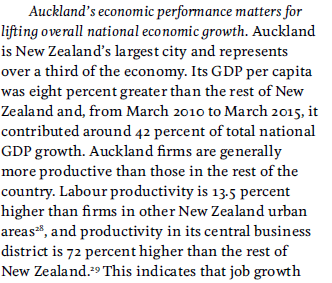
I was drumming my fingers at this point, but then I got to the second half of the paragraph.
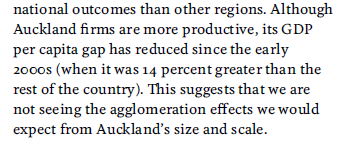
There was much more that could have been said, but for Treasury to acknowledge quite openly – the plain statistical fact – that Auckland incomes have been falling relative to those in the rest of the country, despite the huge infusion of additional people (“most skilled migrants anywhere in the OECD” as I heard Steven Joyce say again this morning) should be seen as pretty damning. There is something very wrong with the model: as they add “this suggests we are not seeing the agglomeration effects we would expect from Auckland’s size and scale”. Perhaps there is no guarantee – or even reason to think – that putting an extra million people or so (the increase in Auckland’s population in the last 50 years or so) in a remote corner of the South Pacific would generate particularly favourable productivity results.
As I’ve noted previously, not only is Auckland’s GDP per capita less high relative to the rest of the country than it was even 15 years ago – the point Treasury now acknowledges – but that margin is small compared to what we see in other countries. I ran this chart, looking at other large cities, in a post a few months ago.
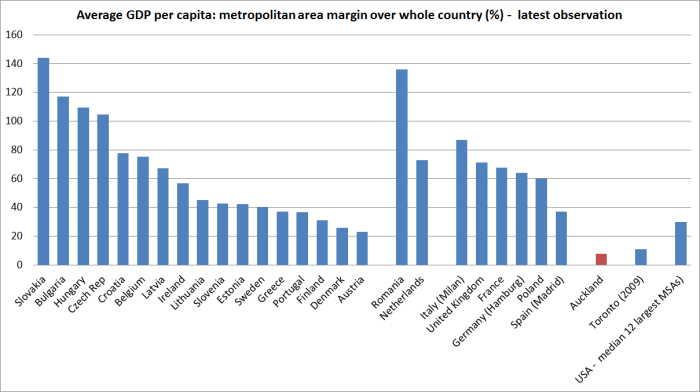
Auckland does poorly. To me, that isn’t surprising. This is a strongly natural resource based economy. There is no sign – and no sign Treasury points to – that it has needed lots more people, and especially not in Auckland.
But Treasury, while clearly a bit troubled, isn’t willing to abandon the faith just yet. The section on Auckland goes on. There are a couple of anodyne paragraphs on Auckland as gateway (people and goods), and Auckland’s transport system, and then we are right back to credal statements.
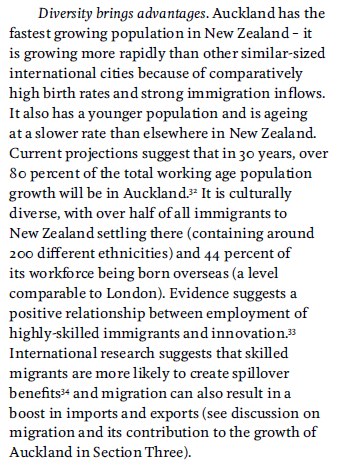
Perhaps diversity does bring advantages, but in the specific case of Auckland, there is just no evidence of solid economic gains. As Treasury notes, Auckland has a fast-growing population, a young population, a culturally diverse popuation, and a very high proportion of people born overseas. But it has a disappointingly poor- and worsening – relative economic performance. In my hard copy of the report I had scrawled next to the comment about London “just a shame, we don’t have their GDP performance”. In the chart above, you can see the contrast between London and Auckland. We really should expect more than faith-based claims from the government’s premier economic advisory agency. As Treasury knows, for example, there is no evidence of a causal relationship between immigtration to New Zealand and growth in innovation, productivity or exports.
(For those interested in the Auckland underperformance issues, the October issue of North and South magazine had a nice article on The Delusions of Aucklanders (and perhaps those advising governments). The article is now available on the new Bauer Media website, Noted.)
Some pages on from the Auckland discussion, Treasury has a page on immigration. It also starts off with a strongly credal tone – keep the faith.
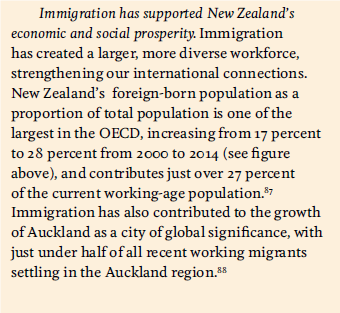
After finishing guffawing at the rather desperate “Auckland as a city of global significance” – had the 9th floor of the Beehive requested that touch, or did they not need to ask? – we might simply ask for some evidence. You might think it would trouble Treasury, even a little, that with one of the largest immigration programmes in the world – of people who, by world standards, are not that badly skilled – we’ve had 25 years of one of the lowest rates of productivity growth in the world. Even Treasury acknowledges that failure. Perhaps there isn’t a causal relationship. Perhaps the productivity performance would have been even worse without the immigration. But not a hint of doubt is allowed into this discussion from our premier economic agency.
But then the drafting gets a little more cagey.

Note very carefully the “can”. Yes, in principle, a good immigration policy can support productivity etc in the right places/circumstances. But Treasury can, and does, advance no evidence that it has, in fact, done so in New Zealand. They really want the public to believe in the programme, while being skilful enough drafters not to allow themselves to be pinned down to have made claims that the economic performance of New Zealanders is actually better as a result of the large scale immigration programme. There is no hint of any evidence that using immigration policy in “addressing short-term skill shortages” makes any difference to longer-term per capita growth and productivity (and I’ve seen no literature on that point internationallly either). And actually, Treasury’s own scenarios suggest that immigration also makes very little difference to the longer-term fiscal challenges.
They conclude, perhaps a little uneasily, reverting to rather more jargon-ridden text.
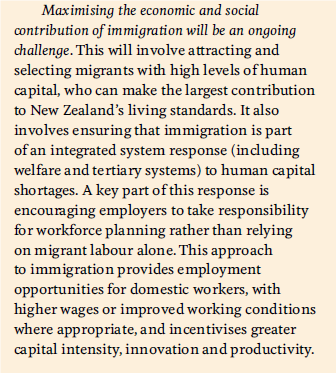
Be very wary of bureaucrats proposing “integrated system responses”, when markets have ways of dealing with issues. Typically, when demand for additional labour and human capital is high, returns to that sort of labour rise, which attracts more people into those jobs, and to developing those skills. “Skill shortages” – or even “workforce planning” – just aren’t some sort of a chronic problem governments need to address. Excess demand for labour is either a sign that monetary policy is a bit loose, or that wages (for that sector or industry, or across the board) should be rising. And if Treasury – or MBIE or ministers – could produce strong evidence that our immigration policy really had boosted productivity and the material living standards of New Zealanders, that would be one thing. But they can’t – and don’t. And don’t forget, that the same OECD survey Steven Joyce was citing again this morning shows that native New Zealanders already have some of the very highest skill levels in any OECD country.
Overall, I guess one gets a sense that Treasury is slowly losing confidence in bits of its story. They now are prepared to acknowledge (at least part of) the sustained underperformance of Auckland. They have raised some doubts about excess reliance of some industries on immigrants. And they still can’t cite any real evidence of sustained gains in the living standards of New Zealanders from the large scale non-citizen immigration programme. But rather than openly addressing the genuine uncertainty – and in what seems a slightly desperate attempt to keep spirits up, and encourage people to “keep with the programme” – we are left with what are little more than slogans, simply asserting the alleged economic gains to New Zealanders from diversity and high rates of non-citizen immigration. A reasonable response should be “well, show us the evidence”.
At the session Treasury hosted yesterday for the release of the LTFS, we were informed that the Productivity Commission is releasing next Monday its “narrative”, in which they will attempt to explain why the New Zealand economy has underperformed for so long, and (presumably) some thoughts on how best to reverse that. I will look forward to that document – there aren’t enough developed competing narratives around a really important issue – and I will no doubt be writing about it here. Given the Productivity Commission’s statist tendencies, I’m not optimistic, but I will be particularly interested in how they deal with the immigration policy and Auckland issues, both in explaining the underperformance of the last few decades, and in contemplating a better way ahead.
The “Compact City” ideals by successive councils are to blame. Restricting the supply of land has misdirected all the money into housing and not building a proper motorway network has meant massive congestion. There are no low cost office parks and inner city start-ups are priced out of the old buildings in the centre. Goods can’t move freely around the place and people are forced to plan meetings and travel around congestion. Virtually all of the advantages of a large city have been squandered by the councils over the years – back to that clown Mayor Robbie and his preference for an imaginary train service ahead of completing the motorway network and expanding the city boundaries.
LikeLike
I didn’t realise that Robbie’s rail was completed but I guess if current failures can be blamed on “imaginary” things then anything goes!
LikeLike
as long as Aucklanders keep voting in train obsessed mayors with IQ’s that could be mistaken for their shoe size then there is little hope for the productivity of the place..
LikeLike
Auckland International Airport handles 17 million inbound and outbound passengers every 12 months, an increase of 10% from last year. 2.6 million tourists fly directly into Auckland. Auckland is not a compact city it is spread over 5,000 skm stretched from Leigh north to Pukekohe south. Travel distance is 129km. Houston stretches only 118 km from The Woodlands north to Texas City South.
The problem with Auckland is the 57 sacred mounts which makes most of Auckland height limited. The CBD highrise at the harbour is isolated to just 500skm. The metropolitan cities, Manukau, Albany, New Lynn and Slyvia park is too far away.
Intercity Rail from Britomart to Mt Eden will cost $3.5 billion. It will not change the traffic congestion. Logic dictates that if you spend $3.4 billion for intercity rail to Mt Eden, you would have rezoned Mt Eden CBD with unlimited heights. But no it is full of single bungalows and not even a decent shopping mall.
LikeLike
If I understand it correctly regional productivity is the sum of firm-level productivity which ignores anything that isn’t in that narrow definition (non-participation in the labour force, voluntary labour etc). I prefer your measure, regional GDP per capita, because there is nowhere to hide on that one.
I tried to read a Motu report on Auckland productivity and had to give up because I don’t have the economics. But if I understood the gist of it they seem to to come down on the side of composition as the main source of Auckland’s higher productivity. This seems to say Auckland only looks productive because more profitable firms locate there; i.e. there is no particular agglomeration effect.It’s just fashion to locate there and it would turn out Palmerston North was a more productive city if those firms relocated there.
I also like to think of Auckland as clipping the ticket on imports (Eric Crampton’s 40% “bought in NZ” cost) and that that makes up most of the region’s apparent productivity superiority.
Wouldn’t break out the cheerleaders for either case.
LikeLike
Re Graeme’s comment above. Auckland could be seen as a great example of a failure of imagination. Even if people do not agree and maybe can never agree on the type of transport required for the city. One would have thought that they could have agreed on the need to provide for North South and East West corridors. The lack of provision for such corridors has from the very start cost the city a fortune.
LikeLike
Auckland International Airport handles 17 million inbound and outbound passengers over 12 months. 2.5 million tourists fly directly into Auckland. That is why Chefs, waiters and cleaners top the list of skilled migrants. Don’t expect a local kiwi to learn how to make indian curries and nann bread or chinese Yum Cha.
It is not a migrant issue. It is because we have elected to make NZ a top tourist destination aiming for 7 million tourists. We will need even more chefs and waiters and cleaners.
LikeLike
Who cares if the Chinese want Chinese food when they come to NZ? We’re not their bloody servants…
LikeLike
So how do we lift Auckland’s economic performance? What are the necessary interventions/policy changes etc. that are necessary at both a local and central government level?
LikeLike
Stop tourism as our top industry.
LikeLike
Stop doing the stupid stuff: free up land use, and (technically, and politically, easier) stop pouring more and more people into the place under our non-citizen immigration policy. In combination they’d make the place more pleasant to live and, in average income or productivity terms, somewhat better off. I doubt Auckland will ever be the “engine room of growth” in this natural resource based economy, but its people can do better than they are, and free up room (lower real interest and exchange rates) for the rest of the country to grow faster too.
LikeLike
Surely lower immigration numbers and more flexible/freer land use wouldn’t be a panacea though? Then again I guess no single intervention would be?
Is there nothing that would force Auckland firms to trade more with the rest of the world and/or expose Auckland to more international competition?
LikeLike
10 million cows generate only $10 billion in export milk. 4.5 million people generate $160 billion in net disposable income. Clearly more people have a smaller footprint and higher productivity than milking cows.
LikeLike
Much lower migrant numbers would produce a much lower real exchange rate (on the one hand), encouraging exporting, and (on the other hand) much less population-growth-based-demand (houses, roads etc) encouraging resources to shift more towards tradables sectors.
Roading infrastructure etc matters too, altho the issues would be much less pressing if the population stabilised (otherwise, i just don’t feel v competent to comment on the transport issues)
LikeLike
Michael, you really need to look at the cause rather then continuosly focused on the symptoms. You can’t solve problems when you just try and harp on incessantly of the symptoms. The cause is our national focus on 2 of the most unproductive and dirtiest industries on the planet, Tourism and Milking Cows.
LikeLike
Clearly I disagree with you about which things are causes and which are symptoms. The deeper causal issue is location/distance. In my view that is greatly exacerbated by immigration policy. Tourism is mostly a red herring – and if there is a focus on it at all, it is really a National Party one – as even 7m tourists, staying 10 nights each is only equivalent to around 200000 people in NZ at any one time (relative to a benchmark of no tourists at all). And as outward tourism is also growing, the marginal effect is much smaller than that.
LikeLike
Then why are chefs the top of the skilled migrant list if not to feed tourists? My version of the cause answers the questions. Don’t forget you are using 356 days a year but peak tourist season is only around 120 days a year which means 450,000 additional people squeezed into a peak tourist period which require feeding and lots of cleaning. Most will come in through Auckland.
LikeLike
yes, fair point re the peaks
re chefs, probably largely because the system is open to being rorted (too many seem to end up in suburban takeways, having found a convenient avenue to NZ residence)
LikeLiked by 1 person
Michael, that is a rather simplistic answer to what is fact. You cannot just write off facts because it does not suit your hypothesis. Our immigration department is paid to police migration and they are tough cookies. If chefs are the top of the list it is because businesses are requesting for chefs. One of mates opened up a Korean restaurant in Auckland which was very successful with sales of $5,000 a day for the last 2 years but because he could not get a replacement chef, he had to shut down the restaurant. He tried to run the business with local assistant chefs but the flavours could not be reproduced.
LikeLike
I don’t have any great stake in the chefs issue. They are up there with aged care workers and retail managers. In most cases, simply not that skilled, and even MBIE acknowledge that the occupational descriptions used in the system simply aren’t fit for purpose (the ANZSIC system was simply designed for use underpinning an immigration system).
LikeLike
I spotted the phrases about highly-skilled migrants being beneficial, or variants, and thought you may have commented on that too. My recollection of your previous comments is that immigrants are on average less highly-skilled than NZers.
OIA-ing the background to “city of global significance” might be entertaining.
OIA-ing papers that NZ immigration policy supports productivity might be interesting. This being intentionally different from the comment that “immigration policy can support productivity”. The intent being to see if Treasury have anything on this subject.
I was pleased to see “encouraging employers to take responsibility for workforce planning rather than relying on migrant labour alone”. I observed tonight’s news had an article about needing more construction migrants in the wake of the recent earthquake. At least I think that’s what it was about, I was too busy ranting about employers not training staff to listen.
LikeLiked by 1 person
Re highly-skilled migrants, I didn’t comment on it as it was worded in a way that I could live with. Even though the average migrant appears to have been a bit less skilled than the average native, at the margin it is quite plausible that we could choose some highly-skilled migrants who would improve average skill levels and probably benefit NZers. I doubt we could attract many, but perhaps it would work if we adopted my 10000 to 15000 annual residence approvals target.
I did OIA Treasury last year on their immigration advice. I wrote about the results here https://croakingcassandra.com/2015/08/11/the-treasury-on-immigration/. Of course, there was no such empirical evidence in a NZ context – and pretty much everyone, even advocates at the NZI, accept that there just isn’t the evidence at present. Presumably they believe that proper structured studies, well done, would show real gains.
An OIA around “city of global significance” is tempting……..
LikeLiked by 2 people
The 10,000 to 15,000 target is merely a target. You can’t have a target drive industry. Industry drives the target. It is a cause and effect issue. Our drive to have agriculture and tourism as our top industries drive a requirement for low skilled labour. As a result we do not need high skilled labour. Our universities train high skilled labour which we do not have enough jobs for and we lose our local high skills to overseas markets that do offer those jobs and as a result have to import low skilled labour to support our top industries, tourism and agriculture.
LikeLike
The seasonal workers visa has increased by another 1000 to 10,500 a year. Clearly low skilled migrants are required, demanded by industry. Again largely our focus in the agricultural industry which is a low productive industry.
LikeLike
Just let a couple of those Auckland volcanoes erupt and Auckland’s GDP will grow fantastically. You won’t need to worry about whether it is migrants or tourists that achieve it.
LikeLike
I suspect its total GDP would drop rather a lot if /when there is ever a serious explosion – it will seem a rather less attractive place to live than it does now. Of course, rebuild/repair efforts might temporarily boost GDP per capita.
LikeLike